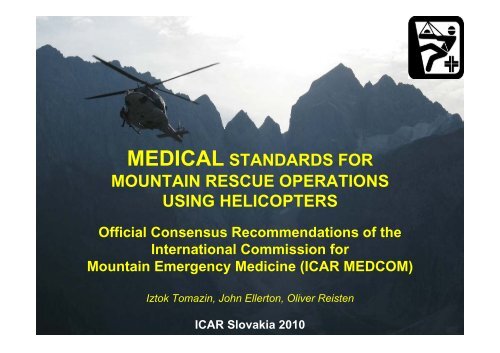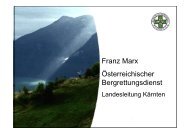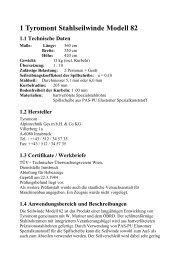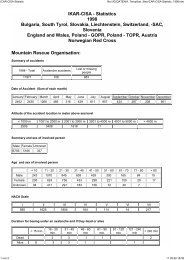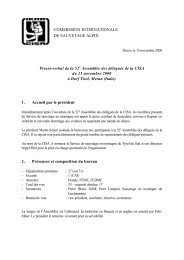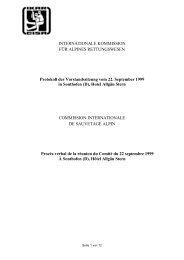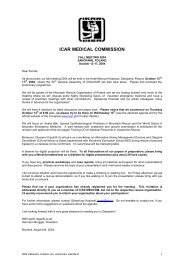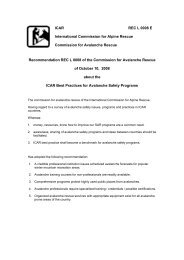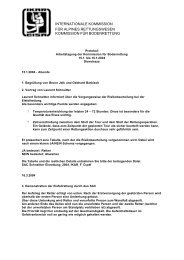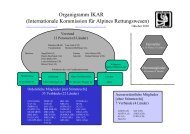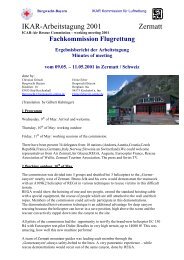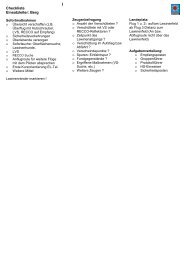medical standards for mountain rescue operations ... - IKAR-CISA
medical standards for mountain rescue operations ... - IKAR-CISA
medical standards for mountain rescue operations ... - IKAR-CISA
You also want an ePaper? Increase the reach of your titles
YUMPU automatically turns print PDFs into web optimized ePapers that Google loves.
MEDICAL STANDARDS FOR<br />
MOUNTAIN RESCUE OPERATIONS<br />
USING HELICOPTERS<br />
Official Consensus Recommendations of the<br />
International Commission <strong>for</strong><br />
Mountain Emergency Medicine (ICAR MEDCOM)<br />
Iztok Tomazin, John Ellerton, Oliver Reisten<br />
ICAR Slovakia 2010
THE PURPOSE OF OUR WORK<br />
To establish <strong>medical</strong> recommendations<br />
<strong>for</strong> safe and effective<br />
Helicopter Emergency Medical System<br />
(HEMS) in <strong>mountain</strong> <strong>rescue</strong>.<br />
ICAR Slovakia 2010
For the severely injured or ill patient,<br />
SURVIVAL IS TIME DEPENDENT.<br />
Helicopters can provide<br />
significant shortening of the times<br />
involved in <strong>mountain</strong> <strong>rescue</strong>.
The north face of<br />
Rjavina in Julian Alps:<br />
hanging climber<br />
with fractured pelvis<br />
SCOOP AND RUN
“STAY AND TREAT”
“STAY AND TREAT”
“STAY AND TREAT”
MEDICAL STANDARDS FOR MOUNTAIN RESCUE OPERATIONS USING HELICOPTERS:<br />
2010 Official Consensus Recommendations of the ICAR MEDCOM<br />
THE FUNDAMENTAL PRINCIPLES OF (H)EMS<br />
IN MOUNTAINS<br />
• Safety is most important!<br />
• Speed and quality of HEMS are critical factors in patient’s<br />
ultimate outcome<br />
• Cooperation amongst all involved services<br />
• Helicopter characteristics <strong>for</strong> safe and effective work<br />
• Appropriate, light and portable <strong>medical</strong> and <strong>rescue</strong><br />
equipment<br />
• Appropriate continuous training and education of all involved<br />
personnel are of utmost importance.<br />
• “Golden hour” (time from the accident to the hospital)
MEDICAL STANDARDS FOR MOUNTAIN RESCUE OPERATIONS USING HELICOPTERS:<br />
2010 Official Consensus Recommendations of the ICAR MEDCOM<br />
ORGANIZATION:<br />
• Helicopter with a <strong>mountain</strong> <strong>rescue</strong> competent crew should be<br />
dedicated to HEMS within a region<br />
• Ideally, every <strong>medical</strong> emergency within the region should be<br />
reached in less than 20 minutes<br />
• Role of Medical Director (quality management, clinical<br />
governance, education etc.)<br />
• UIAA‐ICAR‐ISMM Mountain Emergency Medicine diploma<br />
• Safety Officer responsible <strong>for</strong> a Safety Management System<br />
• Facilities <strong>for</strong> rest, pre‐mission planning and training<br />
• Appropriate <strong>rescue</strong> and <strong>medical</strong> equipment etc.
MEDICAL STANDARDS FOR MOUNTAIN RESCUE OPERATIONS USING HELICOPTERS:<br />
2010 Official Consensus Recommendations of the ICAR MEDCOM<br />
INTEGRATION AND COOPERATION<br />
• HEMS operating in the <strong>mountain</strong>s should be integrated within<br />
the EMS and other emergency systems of the particular area<br />
• Strategies <strong>for</strong> cooperation across international boundaries<br />
are essential.
MEDICAL STANDARDS FOR MOUNTAIN RESCUE OPERATIONS USING HELICOPTERS:<br />
2010 Official Consensus Recommendations of the ICAR MEDCOM<br />
FINANCE should not compromise safety<br />
nor basic principles:<br />
• service is <strong>for</strong> everyone according to <strong>medical</strong><br />
and <strong>rescue</strong> need<br />
• regardless of nationality, insurance or other<br />
influences
MEDICAL STANDARDS FOR MOUNTAIN RESCUE OPERATIONS USING HELICOPTERS:<br />
2010 Official Consensus Recommendations of the ICAR MEDCOM<br />
DISPATCHING<br />
• Dispatch centers should be contacted by a widely publicized<br />
internationally recognized calling number (112, 911…)<br />
• Integrated centers <strong>for</strong> all emergency <strong>medical</strong> and <strong>rescue</strong> calls<br />
are recommend<br />
ommended ed<br />
• Dispatcher should be aware of specific <strong>mountain</strong> <strong>rescue</strong><br />
problems<br />
• Decision to dispatch HEMS should be between the dispatch<br />
center and HEMS team, and should exclude unnecessary<br />
bureaucratic steps<br />
• The final decision to per<strong>for</strong>m the mission remains with the<br />
HEMS team<br />
• The nearest qualified HEMS team to the site of the <strong>mountain</strong><br />
accident, regardless of administrative boundaries, should be<br />
dispatched
MEDICAL STANDARDS FOR MOUNTAIN RESCUE OPERATIONS USING HELICOPTERS:<br />
2010 Official Consensus Recommendations of the ICAR MEDCOM<br />
TIME<br />
Avalanche<br />
survival<br />
curve<br />
TIME IS LIFE<br />
Survival is<br />
time dependant!
MEDICAL STANDARDS FOR MOUNTAIN RESCUE OPERATIONS USING HELICOPTERS:<br />
2010 Official Consensus Recommendations of the ICAR MEDCOM<br />
TIME – <strong>medical</strong> perspective<br />
Survival is<br />
time dependant!<br />
• HEMS activation time (from emergency call to<br />
take off) of < 5 minutes<br />
• approach time (from emergency call to HEMS<br />
team reaching the victim) of < 20 minutes<br />
• minimal standard should be 'as fast as feasible<br />
without compromising safety‘<br />
• Safety supersedes <strong>medical</strong> considerations at all<br />
times!
MEDICAL STANDARDS FOR MOUNTAIN RESCUE OPERATIONS USING HELICOPTERS:<br />
2010 Official Consensus Recommendations of the ICAR MEDCOM<br />
COMMUNICATION<br />
• Robust two‐way communication between<br />
HEMS crewmembers, dispatching centres,<br />
other EMS and the incident site is essential <strong>for</strong><br />
safety, efficiency and <strong>medical</strong> outcome<br />
• personal helmet with an integrated two‐way<br />
radio headset allowing communication at all<br />
times.<br />
• international recognized hand signals
MEDICAL STANDARDS FOR MOUNTAIN RESCUE OPERATIONS USING HELICOPTERS:<br />
2010 Official Consensus Recommendations of the ICAR MEDCOM<br />
TEAM ‐ QUALIFICATION<br />
• All members, including <strong>medical</strong> personnel, should be<br />
trained and regarded as members of the air crew<br />
• Leadership qualities in their area of expertise<br />
• Training in all aspects of <strong>mountain</strong> <strong>rescue</strong> and safety,<br />
and cooperation with terrestrial teams is essential<br />
• The operator should ensure <strong>medical</strong> staff are trained<br />
in its safety management system and CRM<br />
• Local knowledge is essential
MEDICAL STANDARDS FOR MOUNTAIN RESCUE OPERATIONS USING HELICOPTERS:<br />
2010 Official Consensus Recommendations of the ICAR MEDCOM<br />
TEAM ‐ LOCATION<br />
• Ideally all team members are present at the<br />
HEMS base ready <strong>for</strong> immediate activation<br />
• Minimum standard: it may be appropriate,<br />
depending on the service, <strong>for</strong> <strong>rescue</strong> and<br />
<strong>medical</strong> members to be on call with an<br />
appropriate activation time
MEDICAL STANDARDS FOR MOUNTAIN RESCUE OPERATIONS USING HELICOPTERS:<br />
2010 Official Consensus Recommendations of the ICAR MEDCOM<br />
TEAM - TASKS<br />
• “Air <strong>rescue</strong> optimal crew” concept allows <strong>for</strong> different<br />
persons to per<strong>for</strong>m the tasks required, permitting<br />
flexibility in crewing depending on the nature and<br />
complexity of the mission, and the carrying capacity of<br />
the aircraft .<br />
• Specific criteria and qualifications are recommended<br />
<strong>for</strong> the tasks<br />
• It is strongly recommended that <strong>medical</strong> personnel<br />
assess a casualty at the site of the accident except<br />
when the terrain is extremely dangerous and beyond<br />
the competence of the <strong>medical</strong> crewmember
MEDICAL STANDARDS FOR MOUNTAIN RESCUE OPERATIONS USING HELICOPTERS:<br />
2010 Official Consensus Recommendations of the ICAR MEDCOM<br />
‘AIR RESCUE OPTIMAL CREW MEMBER’ CONCEPT<br />
Task<br />
MEDICAL<br />
RESCUE<br />
SPECIAL TASKS<br />
Appropriate activation times<br />
should be predefined<br />
MEDICAL PERSPECTIVE<br />
Crewmember<br />
Qualifications<br />
Doctor, Advanced Life<br />
According to relevant regulations and<br />
ICAR MEDCOM recommendation no. 3.<br />
This includes the ability to per<strong>for</strong>m<br />
<strong>mountain</strong> and <strong>mountain</strong> <strong>rescue</strong><br />
techniques as well as appreciate<br />
<strong>mountain</strong> safety. A higher qualification<br />
in Mountain Emergency Medicine<br />
should be aspired to (MEM diploma).<br />
A high level of experience, knowledge<br />
and proficiency in <strong>mountain</strong>eering and<br />
<strong>mountain</strong> <strong>rescue</strong> techniques.<br />
Task Crewmember Qualifications<br />
Helicopter flying Pilot & HEMS<br />
According to relevant regulations<br />
and operation Support crewmember (ALS)<br />
and ICAR Air <strong>rescue</strong> commission<br />
recommendations.<br />
Medical paramedics, Doctor, Advanced EMT Life or<br />
According to relevant regulations<br />
nurse.<br />
Support (ALS) and ICAR MEDCOM<br />
Ideally a BLS‐<br />
paramedics, EMT or recommendation no. 3. This<br />
trained nurse. EMT, (Ideally nurse a BLStrained<br />
EMT, nurse or <strong>mountain</strong> and <strong>mountain</strong> <strong>rescue</strong><br />
or<br />
includes the ability to per<strong>for</strong>m<br />
paramedic paramedic should<br />
techniques <strong>mountain</strong> as well as safety.<br />
appreciate<br />
assist assist the the ALS‐trained<br />
<strong>mountain</strong> safety. 31 A higher<br />
member.)<br />
qualification in Mountain<br />
member.<br />
Emergency Medicine should be<br />
aspired to.<br />
Rescue<br />
Mountain Mountain<br />
<strong>rescue</strong><br />
<strong>rescue</strong> A high level of experience,<br />
(MR) specialist or or<br />
knowledge and proficiency in<br />
<strong>mountain</strong> guide <strong>mountain</strong>eering and <strong>mountain</strong><br />
<strong>mountain</strong> trained guide<br />
in <strong>mountain</strong> <strong>rescue</strong> techniques.<br />
<strong>rescue</strong>.<br />
trained in<br />
(A minimum MR.<br />
of BLSlevel<br />
first aid of but BLS‐<br />
preferably higher<br />
A minimum level first training aid should but<br />
be<br />
required.)<br />
preferably higher<br />
Special tasks Avalanche dog Regular education and training in<br />
(Appropriate training handler, should cave be<br />
helicopter safety and <strong>rescue</strong>.<br />
activation times <strong>rescue</strong>rs and <strong>medical</strong><br />
required.<br />
should be predefined.)<br />
specialty personnel.<br />
Medical specialty<br />
personnel…<br />
Regular education and training in helicopter<br />
safety and <strong>rescue</strong>.
Medical personnel (doctor) to the site of the accident !
MEDICAL STANDARDS FOR MOUNTAIN RESCUE OPERATIONS USING HELICOPTERS:<br />
2010 Official Consensus Recommendations of the ICAR MEDCOM<br />
QUALIFICATION FOR EMERGENCY DOCTORS IN I<br />
MOUNTAIN HELICOPTER<br />
RESCUE<br />
‣ Physical and mental fitness<br />
‣ Trained <strong>mountain</strong>eer<br />
‣ Com<strong>for</strong>table in exposed situations<br />
‣ Well trained in <strong>mountain</strong> helicopter <strong>rescue</strong><br />
‣ Able to work under extreme conditions<br />
‣ Experienced emergency doctor<br />
‣ Familiar with <strong>mountain</strong> medicine
MEDICAL STANDARDS FOR MOUNTAIN RESCUE OPERATIONS USING HELICOPTERS:<br />
2010 Official Consensus Recommendations of the ICAR MEDCOM<br />
HELICOPTER – MEDICAL PERSPECTIVE<br />
The helicopter must be able to:<br />
• bring the HEMS team to the incident site with<br />
all necessary <strong>rescue</strong> and <strong>medical</strong> equipment<br />
• pick up the casualty and HEMS<br />
crewmember(s) from the incident site<br />
• provide adequate space and equipment <strong>for</strong><br />
per<strong>for</strong>ming <strong>medical</strong> treatment and monitoring<br />
on board
From the <strong>medical</strong> point of<br />
view, helicopter is only<br />
flying ambulance vehicle
AB 214<br />
EC 135
1. Bring HEMS team to the incident site with<br />
all necessary <strong>rescue</strong> and <strong>medical</strong> equipment
2. Pick P<br />
up the casualty and HEMS crewmember(s)<br />
from the incident site
2. Pick P<br />
up the casualty and HEMS crewmember(s)<br />
from the incident site
3. Provide adequate space and equipment <strong>for</strong> per<strong>for</strong>ming<br />
<strong>medical</strong> treatment and monitoring on board
MEDICAL STANDARDS FOR MOUNTAIN RESCUE OPERATIONS USING HELICOPTERS:<br />
2010 Official Consensus Recommendations of the ICAR MEDCOM<br />
MEDICAL EQUIPMENT<br />
‣Should meet national and international<br />
emergency medicine and other <strong>standards</strong><br />
‣Must be light, portable (so as to be brought to<br />
the patient) and robust<br />
‣Must be safely secured during the mission<br />
‣Specialist <strong>medical</strong> equipment and drugs to<br />
manage specific <strong>mountain</strong> related emergencies<br />
(hypothermia, altitude illness, snakebite…)<br />
‣Ergonomic and compartmentalized <strong>medical</strong><br />
rucksacks are recommended.
Portable <strong>medical</strong><br />
equipment<br />
Medical<br />
rucksack
Medical rucksack
Pulse<br />
oximeter<br />
Tympano<br />
thermo<br />
meter<br />
ECG<br />
Glucometer<br />
Set <strong>for</strong><br />
coniotomy<br />
Aspirator<br />
Adjustable<br />
cervical<br />
collars<br />
Used needles<br />
depot<br />
Ampullarium<br />
O2 cylinder<br />
Injection set<br />
Infusion set<br />
RSI drugs<br />
ampullarium<br />
Intubation set
Stethoscope<br />
Soft<br />
cervical<br />
collar<br />
Various drugs<br />
and other items:<br />
intraosseus injection<br />
surgical material…<br />
Pneumatic<br />
and SAM<br />
splint<br />
Suction<br />
catheters<br />
Laryngeal<br />
tube<br />
Bandage<br />
material,<br />
gloves,<br />
disinfection<br />
etc.<br />
O2 masks<br />
Blood pressure<br />
monitor<br />
Bag mask<br />
ventilation<br />
devices
Drugs
RESPECT<br />
FRIENDSHIP<br />
CONFIDENCE
MEDICAL STANDARDS FOR MOUNTAIN RESCUE OPERATIONS USING HELICOPTERS<br />
2010 Official Consensus Recommendations of the ICAR MEDCOM<br />
Iztok Tomazin, John Ellerton, Oliver Reisten<br />
THANK YOU<br />
FOR YOUR KIND<br />
ATTENTION<br />
Prim. Iztok Tomazin, MD, MSc, <strong>mountain</strong> guide<br />
ICAR MEDCOM<br />
Mountain Rescue Association of Slovenia


